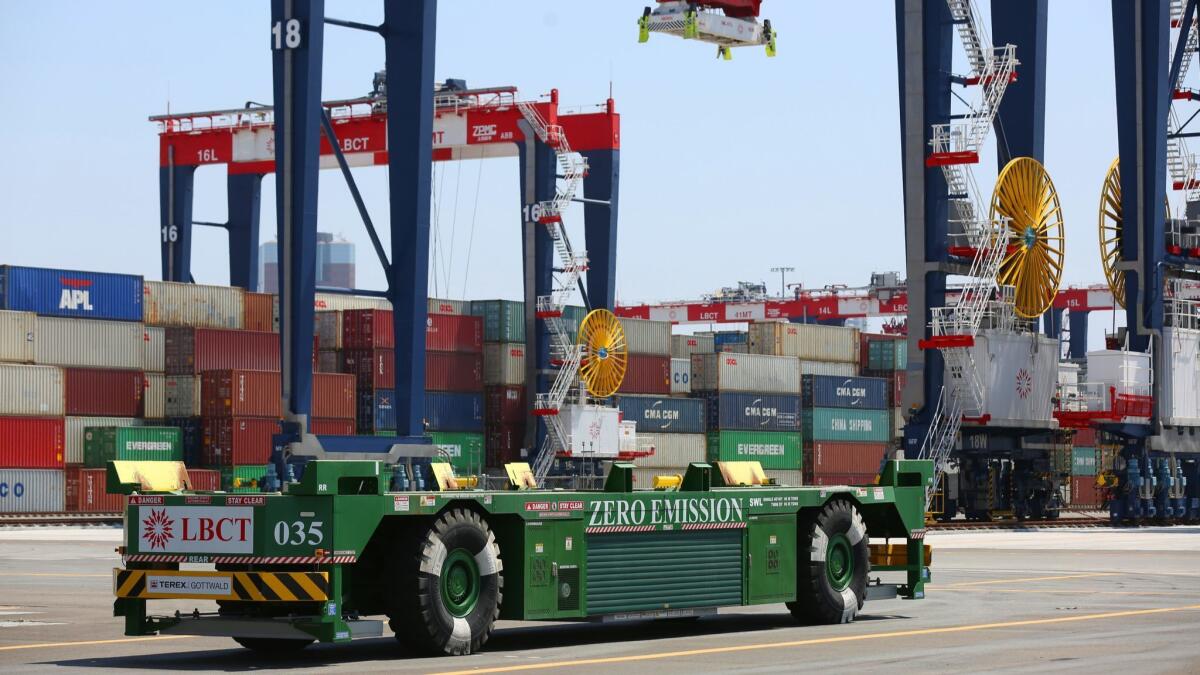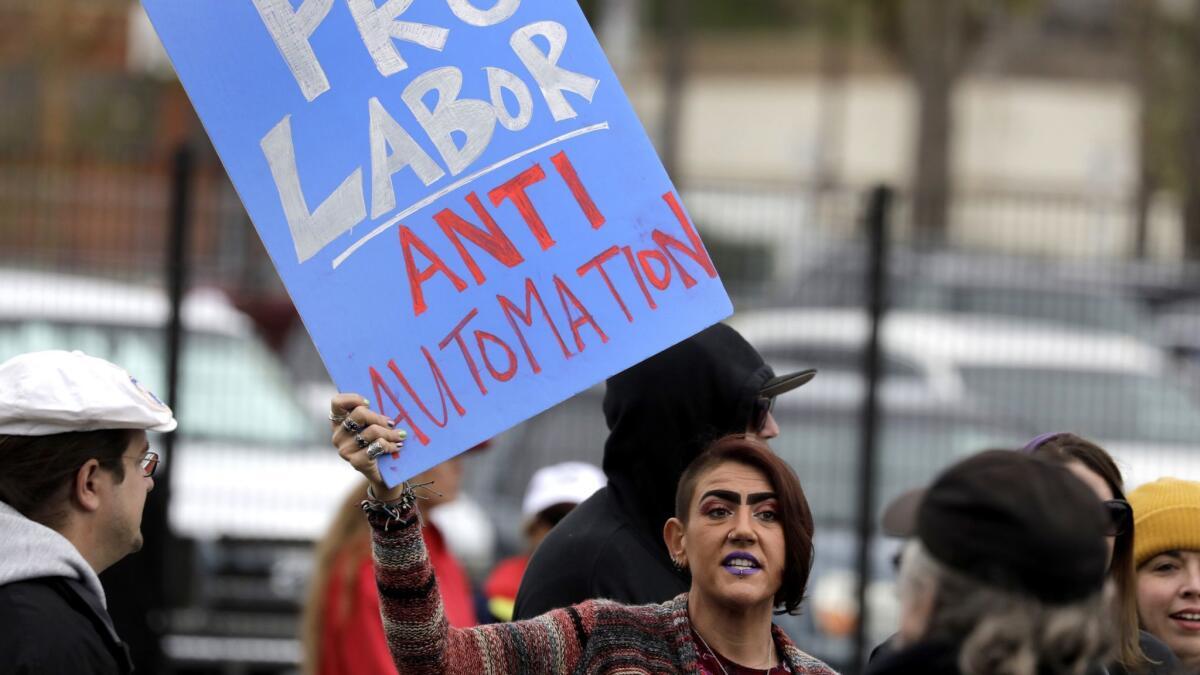Heated battle over automation and jobs at Port of L.A. moves to City Council

- Share via
A fierce battle over automation at the Port of Los Angeles will move to the City Council as dockworkers continue to protest expected job losses at the nation’s largest shipping terminal.
Amid angry shouting by hundreds of members of the International Longshore and Warehouse Union, the Los Angeles Board of Harbor Commissioners voted 3 to 2 on Thursday to approve a permit for Maersk, the global logistics conglomerate, to introduce driverless electric cargo handlers inside its 484-acre facility.
After the vote, which took place at a giant San Pedro cargo-handling facility, City Councilman Joe Buscaino said he would introduce a motion Friday asking the 15-member council to veto the harbor commission’s decision.
The permit requested by Maersk raises “a greater issue over the future of work in the port complex,” said Buscaino, who represents neighborhoods around the port. “This project has been shoved down the throats of the ILWU and the community.”
Moving the matter to the City Council “allows both sides to figure out a path forward,” he added. A draft of Buscaino’s motion circulated Thursday afternoon asks the council for a June 28 vote.
Maersk contends the 130 unmanned vehicles and related infrastructure it plans to install next month will ensure that the Los Angeles port stays competitive with East Coast and Gulf Coast facilities, which have captured a growing share of the market in recent years.
“This is about productivity,” said Wim Lagaay, president of Maersk’s APM Terminals in North America. Los Angeles dockworkers work 16 hours a day, whereas the unmanned vehicles can operate 24 hours a day, he said.
In April and May, more than 1,200 dockworkers marched through the streets of San Pedro and thronged commission meetings, waving U.S. flags and hoisting signs saying “Robots don’t pay taxes,” and “Robots don’t vote.” Some 11,000 people signed petitions against the automation project, and more than a dozen state and local elected officials wrote letters opposing it.
The harbor commission, whose members are selected by Mayor Eric Garcetti, was originally scheduled to decide the issue in March but postponed the vote twice after Garcetti said he would lead negotiations to craft a compromise between Maersk and the union. But three months of talks led by Garcetti’s office have failed to result in an agreement.
In a statement Tuesday, the mayor’s office said he “knows that continued success depends on all parties staying committed to productive discussions around training, safety, and staffing programs that will strengthen the Port and its workforce. The Mayor will continue to engage all parties and is optimistic as talks move forward.”
Meanwhile, opponents are moving to raise the issue before the California Legislature. A bill introduced Monday by Assemblyman Mike Gipson (D-Carson) would give jurisdiction over port automation to the three-member State Lands Commission, consisting of the lieutenant governor, state controller and director of finance.
The lands commission could approve projects on “a case-by-case basis … when the commission determines that the proposed transition to the use of automated technology will provide a safe working environment and not cause critical damage to the state economy or to the economies of surrounding local communities,” the bill states.
Maersk’s Lagaay declined to say how many jobs would be affected by replacing current cargo carriers with the unmanned vehicles. Nor has the company elaborated on what other jobs at its terminal are likely to be automated.
Ray Familathe, president of ILWU Local 13, which represents more than 10,000 dockworkers, said the unmanned vehicles and related equipment would result in a loss of some 500 “work opportunities” daily over two shifts for union members who gather at the hiring hall to accept shift work.

In a statement after the commission vote, the Pacific Maritime Assn., which represents terminal operators, alluded to the fact that the electric cargo carriers will replace diesel-powered vehicles, which have contributed to the region’s air pollution.
“Preventing port terminals from evolving to keep pace with the global economy and to combat climate change threatens to cause long-term damage to jobs, tax revenue, and economic vitality for all of California,” the statement said.
Union leaders have said they do not oppose electric vehicles but claim they can be driven by dockworkers rather than being remotely controlled.
Legally, the ILWU cannot prevent the automation project, because its 2015 contract with West Coast ports explicitly allows automation, building on the union’s tradition of allowing new technology in exchange for high pay and benefits. But Local 13 members contend that, in voting for the 2015 contract, they believed that planned automation involved labor-saving — not labor-replacing — equipment.
Two smaller terminals, one in Long Beach and one in Los Angeles, have introduced unmanned automated vehicles over the last five years, attracting little opposition.
But when union members realized that Maersk’s massive APM terminal was preparing to automate, they came to believe the growing trend represented a major threat to their livelihoods.
In Trump’s trade war with China, L.A. ports are ground zero »
In the negotiations, Maersk reportedly offered to help fund a training center at the port for the union’s diesel mechanics to learn how to repair the new vehicles. But Familathe said the training proposal merely reflects a state-funded upskilling plan already underway and would not be operational until four years after the unmanned vehicles are introduced.
The negotiations “have not been fruitful,” he said in an interview after the vote. “Our union has 1,500 mechanics, and they propose to train 40 a year. This project was fast-tracked. Where is the job impact study? Where is the economic impact study?”
Commissioners voting in favor of allowing the Maersk plan to go forward said they were obliged to do so because the permit in question, a narrow authorization for construction in a coastal zone, conforms to the port’s master plan.
“We are caught in the middle,” said Commissioner Edward Renwick. “The ILWU is legitimately concerned about the impact of automation on jobs. And the terminal operator is legitimately concerned about trying to compete [as the port] has lost market share.”
Nonetheless, Maersk’s testimony that it could not estimate job losses was “preposterous,” he said. “You don’t put together a proposal without a business plan.”
However, Commissioner Diane Middleton, who voted against the permit, said the port’s master plan does require attention to “social and economic justice…. Environmental impacts must include the decimation of the workforce, and that is what we are talking about.”
Twitter: @margotroosevelt
More to Read
Inside the business of entertainment
The Wide Shot brings you news, analysis and insights on everything from streaming wars to production — and what it all means for the future.
You may occasionally receive promotional content from the Los Angeles Times.











